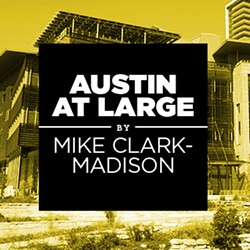Austin @ Large: Canary in the Data Mine
Indicators Project sings Austin blues from atop a three-legged perch
By Mike Clark-Madison, Fri., June 28, 2002

On Monday, the Central Texas Sustainability Indicators Project released its 2002 report: a snapshot of where the five-county Austin metro area stands on 40 different measures of civic health. On Tuesday, as if on cue, the political all-stars behind the LiveableCity quality-of-life coalition kicked off an advocacy campaign that might turn some of those indicators around. (See "Naked City" for more on LiveableCity, which we'll cover at greater length in this space next week.)
To resurrect a cliché, we've got a three-legged stool here -- the Indicators Project, LiveableCity, and don't forget the Central Texas Regional Vision Project. All spring from the same well of sentiment -- things are getting mighty crowded around here, and quality of life is suffering and will only get worse unless we get busy. Both LiveableCity and the RVP are ways to get busy, through advocacy and planning, respectively. The Indicators Project can give directions, but it explicitly does "not attempt to interpret for the community what our indicators are telling us." The canary does not, itself, save the coal mine.
The Sustainability Indicators Project, which started in 1997 and produced its first report in 2000, is known to political literati as the day job of the peripatetic Jim Walker -- president of the Austin Neighborhoods Council, civic point man on Mueller redevelopment, and a board member of both LiveableCity and the RVP. We're tired just writing that sentence, but if you wonder what motivates Project Director Walker and the 23 members of his executive committee -- most with their own many irons in the public fire -- to spend their waking hours helping Austin survive and thrive, look at the indicators themselves. (Officially, Walker works for Austin Community College, the project's institutional home.)
Lots of Patents
The project's mandate is simple -- mine and refine all available data about Metro Austin for a wide range of variables, from the murder rate to the number of patents, from voter turnout to licensed child care centers, from ozone levels to TAAS pass rates. Within the project's frame of reference, all 40 indicators are of comparable importance if you want Austin to become, or remain, as perfect as the local public culture insists we should be. "We don't believe the best way to look at the community is through any one prism," reads the 2002 report, be that "environmental, economic, or class and equity." (The original three legs of the Smart Growth stool.)
The report is not really a report card, since that suggests we know what a passing grade would be, but each indicator is presented with a headnote describing an "ideal state." For example, under "civic engagement," the ideal state is "All Central Texans are engaged in their communities and participate in the civic process." The highest turnout for local elections in 2001 was 38.3% (in Caldwell County), so we have some way to go. (Travis County turnout in November 2000, though a bit higher than other urban Texas counties, was 15 points or more lower than in Raleigh-Durham, San Jose, or Portland, to which the project compares Austin when possible to provide national context.)
Voter turnout is an old, sad story, so what's the good news? Well, crime could be worse, and juvenile arrests (for all ethnicities) are declining. TAAS scores are going up. Household income, as we can all tell, has gone up rapidly. We're using less water, and the air is marginally cleaner. We're getting lots of patents. And on a more subjective note, two-thirds of Metro Austin residents surveyed say they're "very" or "somewhat" comfortable asking a neighbor for help. (That percentage has gone down since 2000, though.)
Nothing But the Facts
No, that doesn't add up to 40. On way too many indicators, and in familiar ways, Austin's sustainability does not look so certain. To go around the stool: Toxic releases are going up, recycling is not, and fewer than half of our larger lakes, rivers, and streams meet Texas(!) water-quality standards. Unemployment is, of course, much higher than it used to be, and what jobs we have are concentrated in a not-diverse-enough economy. (The top 10 private firms, with Dell at No. 1, employ 10% of the Central Texas workforce.) Over one-third of Austin families cannot afford a median-priced home, and over 15% of kids under age 5 live in poverty. There is not a single "exemplary" school, by state accountability standards, east of I-35 and south of US 290, where citizens of color are still heavily concentrated.
Since the project's data comes from various sources, some findings are more solid or timely than others. (Crime, for example, has gone up in many American cities since the report's data was collected.) "There's always more and better data," Walker says, pointing to the flood of Census 2000 info now coming out, which he calls a "gold mine. But there are also big data holes [on indicators like] energy consumption, density [of new growth], and water quality."
As with most products of data mining, while the information is enlightening and often maddening, what do you do with it other than crawl into the nearest hole? While the Indicators Project has not, as mentioned above, attempted to interpret its own findings, "in our current environment, there is an ever-increasing call and need for this to happen," the report reads. The project promises to work on this action item before next summer's report -- though LiveableCity, or the Regional Vision Project, or some yet-unknown constellation of people who care about Central Texas, may by then have already produced a call to action. n
Copies of the 2002 report are available at public libraries throughout the region and online at www.centex-indicators.org.
Got something to say? The Chronicle welcomes opinion pieces on any topic from the community. Submit yours now at austinchronicle.com/opinion.






